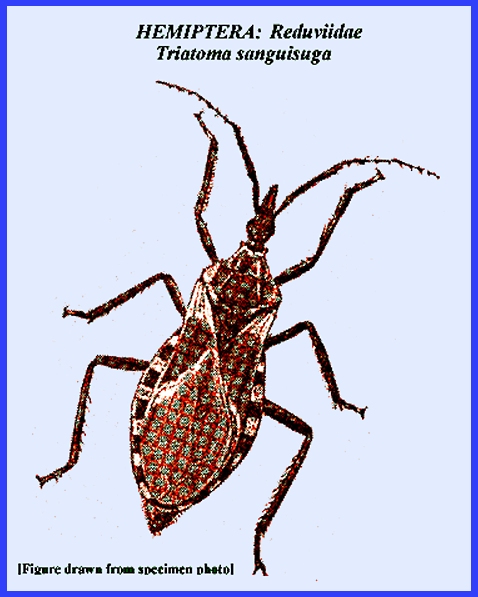File: <hemipterakey.htm> <Medical Index> <General Index> Site
Description
Glossary <Navigate to Home>
|
Arthropoda: Insecta HEMIPTERA KEY (True Bugs) (Contact) Please CLICK on underlined links
to view images or to navigate within the key: To Search for Subject Matter use Ctrl/F [Also see: <Hemiptera
Details>] Hemiptera families or subfamilies of primary medical importance are: Anthocoridae,
Belostomatidae,
Cimicidae,
Coreidae,
Lygaeidae,
Miridae,
Nabidae,
Notonectidae,
Piratinae,
Pyrochorridae,
Reduviidae,
Reduviinae,
Triatominae. The following key separates the important families that attack humans
and animals by biting and/or vectoring diseases:
_ _ _ _ _ _ _ __ _ _ _ _ _ _
_ _ _ _ _ Key References: <medvet.ref.htm> <Hexapoda> Chinery,
M. 1993. Insects of Britain and Northern
Europe 3rd ed.. Cohen, Allen C. 1990. Feeding Adaptations of Some Predaceous
Hemiptera. Ann. Ent. Soc. Amer. 83 (6): 1215–1223.
Coll,
M.; Ruberson, J.R. (eds.) 1998.
Predatory Heteroptera: their ecology & use in biological
control. CAB Direct Org. Czarkowska, J. & S.
Blank-Weissbeg. 1930. The role of the bedbug (Cimex lectularius) in the transmission of
relapsing fever. Warsaw Rev. Appl. Ent (B): 18. Daly,
H. V., John T. Doyen & Alexander H. Purcell 1998. Introduction to Insect Biology and Diversity
2nd ed.. Oxford University Press. pp. 320. Foltz,
J. L. January 23, 2003. "ENY 3005 Families of Hemiptera".
University of Florida.. Forero,
Dimitri. 2008. The Systematics of Hemiptera. Revista Colombiana de
Entomologia. 34(1): 1–21. Goddard, Jerome. 2009.
Bed Bugs (Cimex lectularius) & clinical Consequences
of their bites. JAMA. 301 (13): 1358–1366.
Goddard,
J. & R. deShazo. 2009). "Bed
bugs (Cimex lectularius) and
clinical consequences of their bites".
J. Amer. Med. Assoc. 301(13):
1358–66 Hagler,
J. "Geocoris spp. Heteroptera: Lygaeidae – Bigeyed Bug". In Catherine R. Weeden, Anthony
M. Shelton & Michael P. Matheson, R. 1950. Medical Entomology. Comstock Publ. Co, Inc. 610 p. Service, M. 2008.
Medical Entomology For Students.
Cambridge Univ. Press. 289 p Legner, E. F. 1995. Biological control of Diptera of medical and veterinary
importance. J. Vector Ecology 20(1):
59-120. Legner, E. F. 2000. Biological control of aquatic Diptera. p. 847-870. Contributions to a Manual of Palaearctic Diptera, Vol. 1, Science Herald, Budapest. 978 p. Reinhardt, Klaus & M. T.
Siva-Jothy. 2007. Biology of the bed bugs (Cimicidae). Ann. Rev. Ent. 52: 351–374.
Ruppert, Edward E., R. Fox,
S. Richard, & R. D. Barnes.
2004. Invertebrate Zool., 7th
edition. Cengage Learning. pp. 728, 748.
Shcherbakov, D.
E. 2000. "Permian faunas of Homoptera Hemiptera in
relation to phytogeography and the Permo-Triassic crisis" PDF. Paleontological
Journal 34 3: S251–S267 Usinger, W. E.
1944. The Triatominae of North
and Central America and the West Indies and their public health
significance. U. S. Pub Hlth. Serv. Bull 288. Yorke, W. 1937.
Chagas' disease: a critical review.
Trop. Dis. Bull. 34: 275-300. |
.
